How to Measure Hreflang Success
September 13, 2023Hreflang Demystified Course
October 31, 2023Hreflang X-Default – How to Use X-Default Effectively
BY BILL HUNT
Last Updated: September 5, 2023
The hreflang X-default option creates a lot of confusion on how and when to use it. This guide will explain its purpose and provide several scenarios for using it effectively. When used as developed, it can effectively reduce cross-market cannibalization.
What is the X-Default HREFLang Element?
Multinationals asked for this feature because Google often shows a global home page in Spain or the United Kingdom rather than the market webpage. This was due to the global page often being the most relevant. This negatively impacted rank reporting and sending users to the wrong market when a company was not using IP redirects.
Google introduced the X-default hreflang element in 2013 to designate a webpage that was “configured to point visitors to localized pages, either via redirects or by changing the content to reflect the user’s language.”
For example, the global home page of IBM is https://www.ibm.com. However, if a user visits from Spain, IBM’s language and IP detection will redirect (302 temporary redirect) the visitor to IBM Spain. A visitor from Azerbaijan that does not have a dedicated website would be sent to the IBM Global website at https://www.ibm.com/en/
When initially released, the application of x-default was crystal clear. But as SEOs tend to do, they introduced several “what about” scenarios, resulting in Google modifying the purpose and definition of X-default, creating confusion. Google extended the definition to include country gateway pages where users must select a country to enter and more recently, to set a “fallback” page. These updates will be addressed in context later in this guide.
Google currently defines the use of hreflang x-default as:
The reserved
x-defaultvalue is used when no other language/region matches the user’s browser setting. This value is recommended for specifying the fallback page for users whose language settings don’t match any of your site’s localized versions. While you can use thex-defaultvalue for any page, it was designed for language selector pages and so it will work best with those.
X-Default Syntax
In Page and HTTP Header: link rel=”alternate” href=”https://example.com/” hreflang=”x-default” />
XML Site Map: <xhtml:link rel=”alternate” hreflang=”x-default” href=”https://example.com/” />
You should designate either a single page or a single market, such as your global website, to use the X-Default.
When should I use the X-Default HREFLang?
A few specific scenarios are outlined below where you should use the X-Default.
Scenario 1 -A single page global home page OR use Language or IP detection to serve your users a specific country or language experience.
This is the original reason to set an x-default. Many large multinationals have a global home page for the root domain. For example, Nike. They have the root domain https://www.nike.com, but when I go to that domain from France, there is a 302 redirect to the France market website. There do not seem to be any other pages on the root domain website.

In this case, you would include the root domain in your hreflang cluster and set it to the x-default. This acknowledges the existence of the domain and sets its purpose, instructing Google to use the France website. Without setting the root domain to x-default, you may end up with the problem Nike has with Google showing the root domain for brand queries. In the screen capture below, Google shows the English language root domain in the SERPS with site links to main category pages from the France Market website.
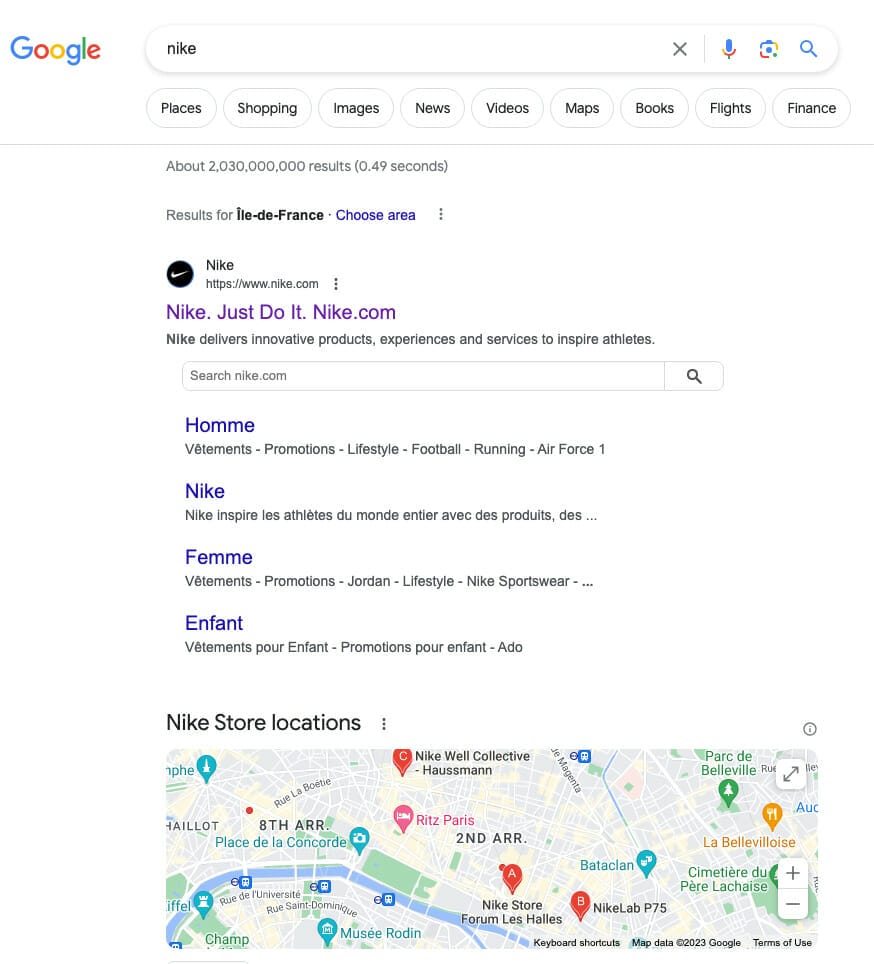
As shown in the redirect screen capture above, the user clicking on the top link in the SERPs will ultimately be taken to France. Beyond rank reporting, the biggest question you should ask is whether there is any cross-market cannibalization with having the English global page presented. Seeing this listing in the SERPs, a user has a couple of options.
- If they only look at the headline and the first listing, they may not click as they may assume they will be delivered to the global or US home page. They may try another query.
- Fortunately, in this case, Google has site links to French-language pages that give alternatives to the user. As shown above, searchers from France clicking on the listing will be redirected to the France home page.
Scenario 2 – A country or Language selector where you force users to make a selection before entering the site.
This is the case with sites like Fedex.com. When users visit the site, they have to pick their country or language of preference, setting a cookie to get them back to the original page.

WHY: This selector page is not tied to any specific language or country. Its purpose is to do exactly that, have the user select their language/country preference. In this scenario, this will be the ONLY page using X-Default.
Scenario 3. A fallback version of the website to present to any market without a local version.
With this scenario, you want/need the global version of the site to show up in search results where you don’t have a local language version. This is not for a regional site like LatAm, where you are trying to cover multiple countries and languages with the same site. For specifics on using HREFLang for regional sites, please review our guide.
Huawei is an example of this. While they offer 107 individual country and language versions of the site, they have a Global English version that is the default site to show when they do not have a local version.
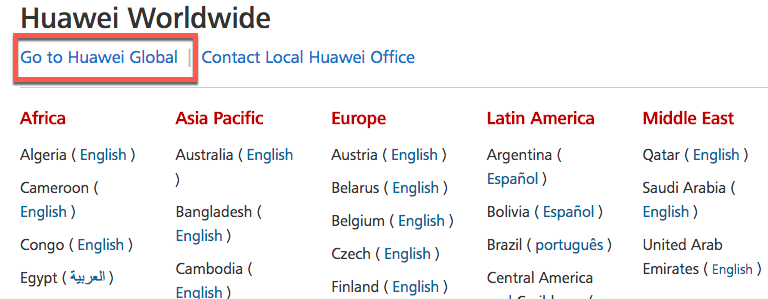
WHY: It tells Google this is the default option when there is no local version. Without an X-Default, Google may show any other website in that market, which may cause cannibalization of that market and unhappy searchers.
For example, IBM has 65 language/country versions of its site. Depending on where you come from, you will get pointed to a market-specific version of the site. What happens when a user comes from Uzbekistan looking for cloud computing information? Since they don’t have a Uzbekistan site, they may want to see the “master global page” for cloud computing. https://www.ibm.com/cloud-computing/. By setting the global page to X-Default, Google would serve that global cloud page to those from Uzbekistan.

WHY: It tells Google this is the default option when there is no local version. Without an X-default, Google may show any other website in that market, which may cause cannibalization of that market and unhappy searchers.
Scenario 4. No Fallback Language Website
Many sites do not have a global or fallback version of their website. They may only target a single market or a specific region or don’t have a site that can be understood outside of those language targets to use as a fallback for x-default. In this case you don’t need to use the x-default.
We had a question from a website owner with a Danish and German language website if they should use an x-default and if so, which site. We told them that while German is widely spoken, did they want to target searchers outside of those language markets and if so do they think the users would have a good experience? We suggested they not use X-default since they do not meet any of the first three scenario conditions.
Common Hreflang X-Default Errors
The most common Hreflang Error is to set conflicting markets as the x-default. Remember, with the X-default option, you are trying to tell Google you have made a selection for a fallback or website to show in specific markets. If you set it to multiple markets, it will ignore the request altogether. Below is an example of this incorrect deployment.
This problem typically occurs when there is no coordinated strategy for deploying hreflang and markets deploy their hreflang or when the CMS is deployed in multiple markets without coordination.
In this example, the car company Genesis has multiple markets for the X-default. In this first screen capture, the Canada English website has set itself as the x-default.
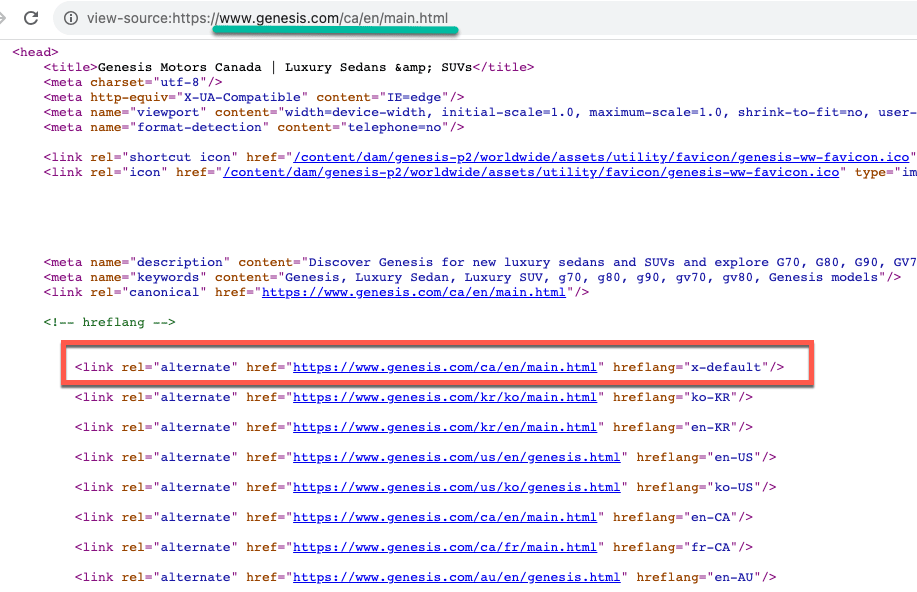
In this screen capture, the French Language Canada website, has also set itself as the x-default
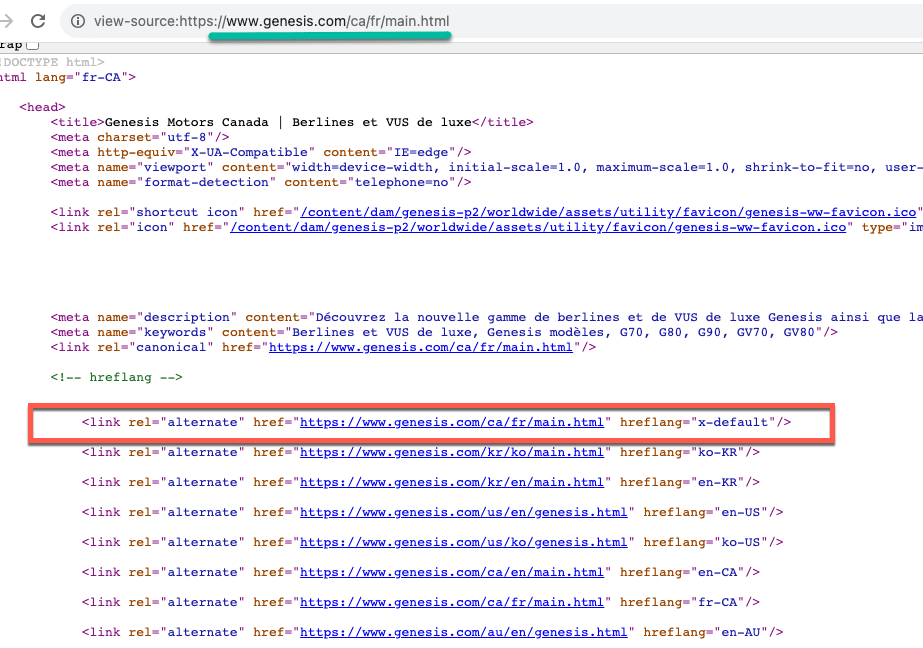
The Middle East regional website was set the X-default as well. We have had many SEOs believe the X-Default was a regional setting and could set it to indicate a regional preference. Given there is no location or language nuance to x-default, there is no way for a search engine to know this is a regional setting. Also, note the variation of the country ISO they are using. For Saudi Arabia, they have tried to append a city, and in the last row they tried to use a regional name as an ISO country tag.
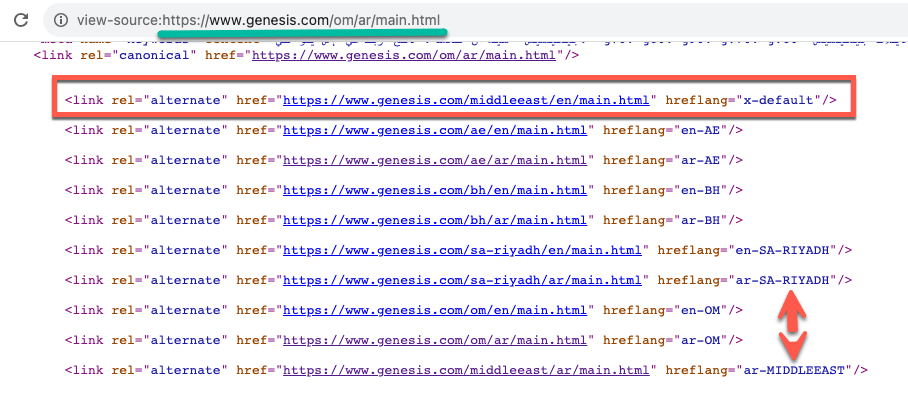
The screen capture below, they have set the x-default to the worldwide English page, which seems like the perfect fallback page.

X-Default Setting Frequently Asked Questions
Yes. You can set a URL as the X-default and a second entry to designate a specific market. This is common for multinationals where their global site is also their US website. Without a designated US website, you can set the global site to “en-US.”
Dropbox has implemented it this way. Their main website represents them globally as well as in the US market. They have set the pages on this website to map the global site to both X-Default and to en-US
link href=”https://www.dropbox.com/” rel=”alternate” hreflang=”x-default” />
link href=”https://www.dropbox.com/” rel=”alternate” hreflang=”en” />
link href=”https://www.dropbox.com/en_GB/” rel=”alternate” hreflang=”en-gb” />
Another variation is Ancestry.com, where they map the global site to both X-Default and to en-US
link rel=”alternate” hreflang=”x-default” href=”https://www.ancestry.com/” />
link rel=”alternate” hreflang=”en-us” href=”https://www.ancestry.com/” />
Comment: While you can do it, and it does not hurt anything, it is one extra action. Many sites do it to check the box. Since the US does not technically have a site, the X-Default will be the site that should appear in the US.
English is the typical language version chosen for x-default due to the number of English speakers worldwide. If you only have Spanish language sites and sell to Spanish-speaking customers, you can use one of your Spanish sites for X-default. Remember, the purpose of X-Default is to designate a selector page or to set a fallback version of the website for those markets that do not have a dedicated site.
No, you don’t have to use an x-default in your hreflang cluster. Some tools may flag your hreflang as being incorrect without it but it is not required. You would not use it, especially if you don’t meet any of the scenarios above.
A fallback page relative to hreflang is a page that should be shown to searchers when you don’t have a dedicated market website.
The x-default in your XML sitemap is a hreflang attribute that designates a specific page for the search engine to present to searchers from markets where you do not have a dedicated market website.
No. There is no requirement to use an x-default element in your hreflang. You are encouraged to use it if you have a country or language gateway page, use IP redirection, or want to set a fallback webpage.
The x-default value in your XML sitemap is a hreflang attribute that designates a specific page for the search engine to present to searchers from markets where you do not have a dedicated market website.
